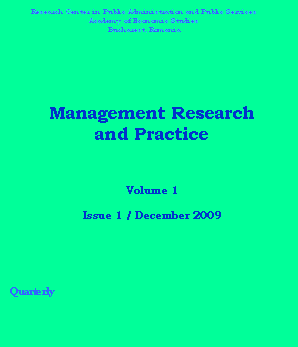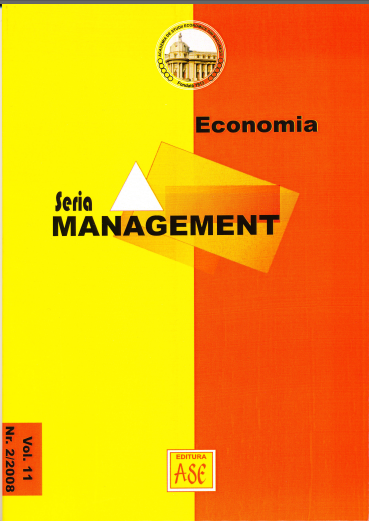
BUSINESS EXCELLENCE AND MANAGEMENT
ISSN
2248-1354 (print)
2668-9219 (online)
ISSN-L: 2248- 1354
|
Home |
|
| Journal description | |
| Aims and scope | |
| Publication ethics | |
| Indexation | |
| Editorial information | |
| Editorial team | |
| Editorial Board | |
|
Journal content |
|
| Current issue | |
| Previous issues | |
| Special issues | |
| Guideline for authors | |
| Submission | |
| Manuscript style | BEMAN Template |
|
|
| Volume 3, Issue 4, December 2013 |
|
1. STEPS TO EXCELLENCE IN THE INDUSTRIAL ENTERPRISES MANAGEMENT Ion VERBONCU
The Bucharest University of
Economic Studies, Bucharest |
|
The paperwork aims to identify the most important strengths and weaknesses of the management and, on this basis, to point out some modalities to amplify the viability potential of the car making enterprises. From the perspective of their performances amelioration, the managerial reengineering, promotion of the strategic management, promotion of managerial complex and sophisticated tools, improvement of the organizational and managerial culture parameters, transformation of the managers in decisive factors of the process of achieving excellence in management and business are decisive. There are pointed out the ways of manifestation of the enterprise’s performances and the impact of the managerial modernization modalities toward them. ... |
|
2. THE MORAL MANAGER: REGAINING ETHICS FOR BUSINESS
Ştefan-Dominic
GEORGESCU
|
|
The paper refers to a distinction between limitative and generative ethics. The main idea is that, if ethics is to be of any help for managers, it has to provide applicable principles that can morally orient managerial decisions, and avoid abstract principles that are usually used not to help managers, but to sanction their decisions. ... |
|
3. THE VIRTUAL ORGANIZATION IN THE GLOBALIZATION ERA
Oana Elena CROITORU |
|
In this paper we introduce some aspects regarding the globalization and the virtual organization (as a new organizational structuring), asserting the main advantages, disadvantages and relevant characteristics. ... |
|
4. ASSET ALLOCATION AND PORTFOLIO OPTIMIZATION PROBLEMS WITH METAHEURISTICS: A LITERATURE SURVEY
Bilel JARRAYA |
|
The main objective of Markowitz work is seeking optimal allocation of wealth on a defined number of assets while minimizing risk and maximizing returns of expected portfolio. At the beginning, proposed models in this issue are resolved basing on quadratic programming. Unfortunately, the real state of financial markets makes these problems too complex. Metaheuristics are stochastic methods which aim to solve a large panel of NPhard problems without intervention of users. These methods are inspired from analogies with other fields such as physics, genetics, or ethologic. Already various Metaheuristics approaches have been proposed to solve asset allocation and portfolio optimization problems. In a first time, we survey some approaches on the topic, by categorizing them, describing results and involved techniques. Second part of this paper aims providing a good guide to the application of Metaheuristics to portfolio optimization and asset allocation problems. ... |
|
5. EXTRA-FINANCIAL DISCLOSURE AND THE COST OF DEBT OF BIG FRENCH COMPANIES
Ahlem NAJAH |
|
The literature shows that there is a lack of studies concerning the relationship between corporate social responsibility and cost of debt in the French context. To participate in filling this gap, we present this work seeking to investigate the relationship between non-financial disclosure and the cost of debt of 202 big French companies from 2000 to 2010. Results of the empirical study show that there is no explicit relation between the social reporting and the cost of debt but when adding size and age as control variables, this relation tends to be negative. ... |
|
6. WORKFORCE/MANPOWER, DETERMINING FACTOR OF PRODUCTION WITHIN A FIRM
Alexandru TRIFU |
|
Numerous studies demonstrate there is an indestructible relationship between educating, training and motivating the young generation and assuring the well-being and progress of any economy, by providing the necessary features of the manpower. This study aims to emphasize the outlook of some important regions of the world economy, regarding the formation of manpower as a result of the implication of the education systems and governments representatives in this process, given the present economic and social environment. Furthermore, we also want to emphasize the difference between manpower and workforce, the last one being the physical approach of the labor. But, together with the ideas, skills, capabilities, competencies, charisma, the spirit to undertake the business risks, capacities for innovation, in a word, manpower + entrepreneurship factor of production is determining in the functioning of any economic activity, or business and support the progress and the trends towards wealth and well-being of any party involved in. The use of new terms, the reinvention of the work models, a stronger link of the economic phenomena and processes with the human factor, this is the current period main characteristic. ... |
|
7. CONSIDERATIONS REGARDING THE POLY-SERVICING OF THE WORKPLACES IN THE MACHINE BUILDING INDUSTRY
Gabriel MIREA |
|
In the machine building industry it is met a wide variety of operations, and the most machines work after a regular cycle of processing, which generally takes place without the operator intervention, which favours the application of the workplaces poly-servicing system. In the first part of this article I made reference to the cycle of the processing on the machine tools, highlighting the analysis stages of the main aspects of the processing, as well as the determining procedure for the maintenance service cycle of the machine tools. Next I presented the main parameters used to characterize the poly-servicing and aspects of combining the processing operations under the poly-serving system, exemplifying the method of calculating of the optimal number of the machines that can be served by a single operator. ... |
Other ASE journals


